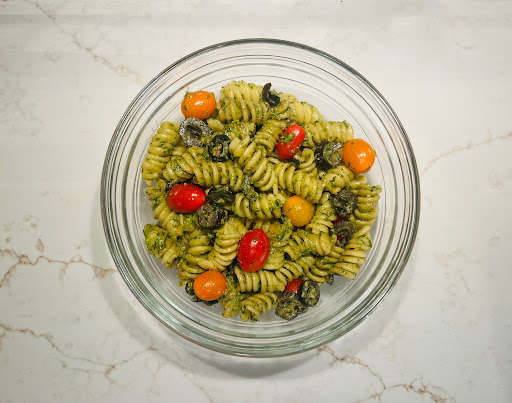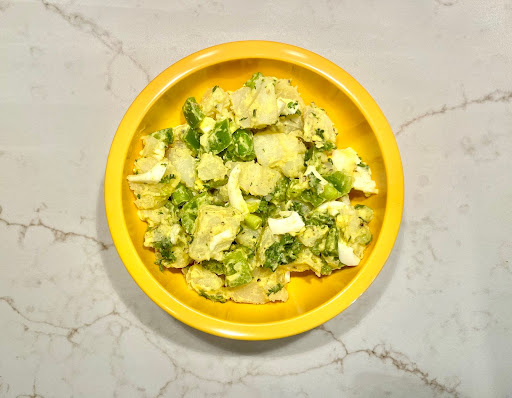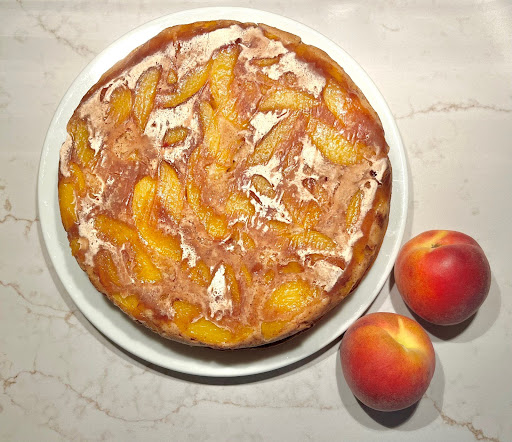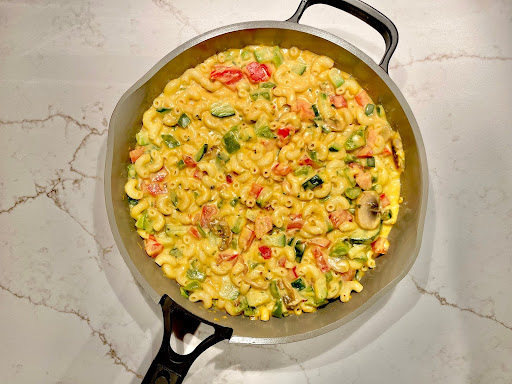A pasta that is both indulgent and incredibly healthy! Enjoy multiple servings of veggies in this pasta primavera that goes slightly against the classic thanks to smoked gouda and breadcrumbs.
THE INGREDIENTS:
Pasta: We like to use fusilli or rotini pasta in this recipe. We find that their helical shape means that they can hold a lot more sauce than a straighter pasta, such as penne. So, any twirly pasta shape works perfectly for this recipe! However, using what you have is a good thing-even if the pasta is not the shape we use here.
Cherry Tomatoes: Besides their stunning red color, these cherry tomatoes provide a “pop” of tomato juice and flavor. Since the sauce primarily consists of cream and cheese, these tomatoes bring the acid. They brighten up the dish and balance out all that fat!
Carrot: Often used in soups and stir fries, carrots don’t find their way into pasta that often. Usually, carrots take what feels like ages to cook, but blanching them makes them ready in a matter of minutes. This allows us to incorporate them easily and quickly into this meal. Another brightly colored vegetable, carrots help us eat with our eyes first. Carrots are important for our variety of veggies. We don’t want to use all similar veggies because it would make the overall dish very monotonous.
Broccoli: Unlike juicy tomatoes and soft carrots, broccoli adds a bite to this dish. When cooked well, broccoli is truly delicious and pairs well with the creamy and cheesy sauce-there is a reason why broccoli cheese soup exists, so pasta with cheese and broccoli in it is bound to go just as well!
Orange Bell Pepper: Yellow, orange, and red bell peppers are sweeter than their green counterpart. We wanted to incorporate some sweetness into this dish by choosing vegetables, such as carrots and bell pepper, that are naturally sweet. Bell peppers also blanch well and pair with tomatoes, which are also in this dish. You can substitute any bell pepper, but we found that the orange bell pepper gives this dish the best presentation. We already have red cherry tomatoes and yellow bell peppers don’t stand out in the sauce.
Garlic Cloves: Garlic is one of the key seasonings in this recipe. The number of cloves can be easily adjusted depending on clove size or your own preference. When we say 3 garlic cloves, we mean 3 medium-to-large cloves, not small ones! If you don’t feel like mincing garlic cloves, reach for ¾ tsp of garlic powder.
Yellow Onion: Onions and garlic pair incredibly well together and add more flavor to this pasta recipe. We often have yellow onions on hand, so we use those. However, the yellow onion can easily be replaced with almost any type of onion-just avoid the red onions! If you use shallots, you should use at least 2 due to their smaller size and more mild flavor. If you don’t feel like dicing an onion, reach for roughly 1 tablespoon of onion powder or 2 tablespoons of dried minced onion.
Salt: A basic, important ingredient! The amount of salt can be adjusted to your preference. This dish doesn’t taste salty, so 1 teaspoon of salt should meet the preference of most people.
Black Pepper: Another basic ingredient! Salt and pepper go well together and with only ¾ tsp, this meal does not taste too peppery. Adjust this to your preference, though!
Fresh Basil: Fresh basil adds noticeably more flavor than dried basil in this dish. The freshness of basil goes well to lighten this meal. If you don’t want to mince basil or can’t justify buying a whole bundle, you can always buy basil paste. It lasts much longer and still tastes fresh! Replace the fresh basil with equal amounts of basil paste or replace with 1 tsp of dried basil. If you are using dried basil, add the dried basil during the vegetable broth addition step. Dried basil needs to cook longer for maximum flavor. With fresh basil, only cook it for a minute! The longer you cook it, the weaker the flavor gets.
Veggie Broth: To have the sauce be entirely made up of cream and cheese would make it more like a mac n cheese than a pasta primavera. By using veggie broth, we are able to make a light sauce that still has a creamy flavor. If you don’t have veggie broth, good substitutes would be chicken broth, water with bouillon, or pasta water. Pasta water is starchy, allowing the sauce to thicken more.
Heavy Cream: Only a little bit of cream goes a long way in this recipe! Although we highly recommend using cream in this recipe, milk can be a good substitute, just be aware that the sauce will be thinner. If you don’t have cream and use milk instead, replacing the broth with pasta water may be a better choice.
Butter: Butter provides a richness and a better base to the sauce than other oils. Since there is not a ton of cream in this recipe, butter helps to up the fat and make this pasta more decadent.
Smoked Gouda: The smokiness and strength of the gouda cheese really helps to bring this pasta to the next level. Gouda melts well so it only needs to be cut into cubes before it is added to the sauce. If you want to make this pasta primavera more authentic, we recommend substituting the smoked gouda with parmesan cheese.
Breadcrumbs: One thing that most pasta dishes miss is texture. You often get the same bite over and over again, which can begin to feel boring. Besides combating this by adding a variety of different vegetables, we like to add breadcrumbs so that you get a crunchy texture. You can buy premade breadcrumbs at the store. You can also blend hard bread (hard due to being old or being toasted) in a blender or food processor until they are the size that you prefer.
Italian Seasoning: An easy way to keep the breadcrumbs from tasting bland! If you wish, you can skip the seasoning step by buying pre-seasoned breadcrumbs.
Cornstarch: We are making pasta, not soup! So, if you find that your sauce is too thin to really adhere to the pasta at all, we recommend a cornstarch slurry. By mixing cornstarch and water together first, you prevent any possible clumps that could occur in the sauce. We like to use cornstarch instead of flour because it is easier to add at varying points while cooking and is a bit stronger than flour in thickening ability.
KEY INFORMATION:
Blanching: Blanching is when you boil your vegetables for a short period of time before immediately immersing them in a bowl of ice water. The ice water stops their cooking process. Not only does blanching cook your vegetables fully and quickly, but it helps them to retain their bright color.
Saving Time: Since you already have to cut and blanch so many vegetables, this recipe may seem a little intimidating if you are low on time. While we don’t recommend skipping any of the vegetables, we do think you can take a shortcut when it comes to the garlic and onion. Replace the garlic with ¾ tsp of garlic powder and the onion with 1 tablespoon of onion powder or 2 tablespoons of dried minced onion. You could also use frozen vegetables that you have.
Cooking the Cherry Tomatoes: While the cherry tomatoes can just be added, uncooked, at the end and warmed up during the last few minutes of cooking, we prefer roasting them in the oven first. A barely cooked cherry tomato is full of juice and “pops” when you take a bite, but a roasted cherry tomato is still juicy with an even more intense, savory flavor. Do what you prefer, but we recommend giving roasted cherry tomatoes a shot!
Matchsticks and Small Florets: The cut of the vegetables really matters in this recipe! Although easier, cutting the carrots into coins or half-coins makes them seem too chunky and out of place in this recipe. While matchstick carrots can be bought at the grocery store, we recommend cutting these by hand so that you can get a slightly thicker matchstick. We also recommend taking the time not to just chop the broccoli into florets, but small florets. Large florets make it hard to get a bite of broccoli and pasta all at the same time, whereas smaller florets go better with the overall dish.
Adding the Cream at the End: You do not want to risk overcooking a dairy product. If you accidentally set your heat too high and your cream is already in the dish, it risks curdling and tasting awful.
What is a Slurry? A slurry is a combination of cornstarch and water in order to form a paste. The key of a slurry is to add enough cornstarch. For a pasta sauce like this, 1 tablespoon is sufficient and we do not recommend going above this. The two tablespoons of water are just to form a paste, so do not feel a need to follow the amount of water exactly. Your only goal is to make sure that the cornstarch is entirely a wet paste and has no dry parts. If you were to just dump dry cornstarch into your sauce, it would form unappetizing “clumps” and actually not thicken your sauce. Talk about a mess!

Ingredients
Method
- Preheat the oven to 375 F.
- Get a pot of water on the stove and turn the heat to high so it comes to a boil.
- Cut the cherry tomatoes in half and put on the baking sheet with ¼ tsp salt, ¼ tsp black pepper, and 1 TB olive oil.
- Put the cherry tomatoes in the oven and bake for 20 minutes.
- Prepare a medium bowl with icy water.
- Cut the carrots into matchsticks.
- Blanch the carrots for 2 minutes in the boiling water. Transfer to the bowl of icy water.
- Dice the orange bell pepper.
- Blanch the bell pepper for 2 minutes. Transfer to the bowl of icy water.
- Cut the broccoli into small florets.
- Blanch the broccoli florets for 3 minutes. Transfer to the bowl of icy water.
- Dice the yellow onion.
- Add 1 tablespoon of the olive oil and the diced yellow onion to a medium frying pan at medium heat.
- Cook the onions until they are translucent.
- While the onions are cooking, get a pan full of water boiling (don't use the blanching water!), add the fusilli pasta and cook for 10 minutes.
- Add breadcrumbs to a baking sheet and ¾ tsp Italian seasoning. Put in the oven and bake for 8 minutes.
- Dice the garlic cloves.
- Once the onions are translucent, add the butter and garlic cloves to the pan.
- Cook for about 1 minute or until the garlic is fragrant.
- Add the vegetable broth, salt, and pepper.
- Shred the smoked gouda cheese or cut it into small pieces.
- Take the pan off of the heat. Add the heavy cream and smoked gouda cheese. Stir until the cheese is fully incorporated.
- If the sauce is too thin for your liking, combine cornstarch and water to form a slurry. Add it to the sauce and stir, returning the pan to medium heat, until the sauce is at the desired thickness.
- Add the fresh basil, vegetables and pasta. Cook for 2 minutes or until the vegetables are warm.
- Top with the breadcrumbs.
- Enjoy!




Leave a Reply